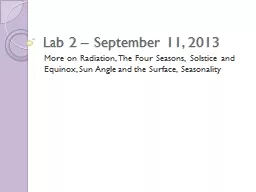

More on Radiation The Four Seasons Solstice and Equinox Sun Angle and the Surface Seasonality Radiation Review Everything emits radiation Tgt0 Kelvin StefanBoltzmann Law E σT 4 StefanBoltzmann Constant σ 00000000567 Wm ID: 569519
Download Presentation The PPT/PDF document "Lab 2 – September 11, 2013" is the property of its rightful owner. Permission is granted to download and print the materials on this web site for personal, non-commercial use only, and to display it on your personal computer provided you do not modify the materials and that you retain all copyright notices contained in the materials. By downloading content from our website, you accept the terms of this agreement.
Slide1
Lab 2 – September 11, 2013
More on Radiation, The Four Seasons, Solstice and Equinox, Sun Angle and the Surface, SeasonalitySlide2
Radiation Review
Everything emits radiation (T>0 Kelvin)
Stefan-Boltzmann Law:
E = σT4Stefan-Boltzmann Constant σ = 0.0000000567 W/(m2K4)Energy Emitted ∝ Temperature (to the fourth power)
Where is the greatest radiation
measurement? The least?
Note: Temp of Clouds < Temp of SurfaceSlide3
Downwelling Radiation
Downward emission of infrared energy (in our case, from clouds)
Results in higher surface temperatures
e.g. Cloudy nights are typically warmer than clear nights
Intensity of
downwelling
radiation
Increased surface temperaturesSlide4
Incoming Solar Radiation and the Atmosphere
Some solar radiation traveling through the atmosphere is
back-scattered
Solar radiation striking the earth at an angle travels through more atmosphere
Clouds in the atmosphere back-scatter
a lot of incoming sunlight
Which person experiences more intense sunlight?Slide5
The Four Seasons
Earth’s axis always points in the same direction in space
Time-lapse photography showing concentric, circular star trails
What astronomical feature is in the center?Slide6
The Four Seasons
Variations in seasonal temperatures is a result of the Earth’s tilt
Sun Directly over-head at 23.5° S
Sun Directly over-head at 0°
Sun Directly over-head at 0°
Sun Directly over-head at 23.5° NSlide7
Solstice and Equinox
(Northern Hemisphere)
Date
Latitude of Direct Sunlight
Summer SolsticeJune 2123.5° N (Tropic of Cancer)Winter Solstice
December 21
or
22
23.5° S (Tropic of Capricorn)
Autumnal Equinox
September 22
0°
(Equator)Vernal (Spring) EquinoxMarch 200° (Equator)
Note: Solstices are reversed for Southern HemisphereSlide8
Sun Angle and the Surface
The greater the sun angle, the more concentrated the radiation is when it strikes the surfaceSlide9
Seasonality
Annual range of temperature at a location
i.e. swings in temperature between summer and winter
Major controllers in seasonality:LatitudeProximity to large bodies of waterSlide10
Seasonality (Latitude)
Higher latitudes receive widely varying solar radiation throughout the year
Think about hours of daylight in each season
North Pole?Equator?Slide11
Seasonality (Bodies of Water)
Heat Capacity – a measure of the ratio of the amount of energy absorbed (or released) by a substance to the corresponding temperature increase (or decrease)
If it requires 40 units of energy to increase the temperature of one gram of dirt by one Kelvin and requires 120 units of energy to increase the temperature of one gram of water one Kelvin, which substance has a higher heat capacity?
H.C. Water > H.C. LandSlide12
Seasonality (Bodies of Water)Slide13
Seasonality (Bodies of Water)Slide14
Lab 2 Problems
2.7a,b
2.10a,b
2.11a,b2.13a,c,d3.13.43.63.9a,b,cDUE FRIDAY
BEFORE CLASS